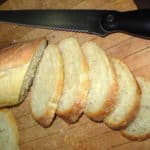The Best Basic White Bread from a Sponge
Once you have made the sponge (recipe here), you can continue with the rest of the recipe (either immediately or after the sponge refrigerates for 8 or more hours).
Servings: 24
Calories: 127kcal
Ingredients
The Sponge
- 1 cup warm water about 115 F
- 1 Tablespoon dry yeast
- 1 Tablespoon sugar or honey
- 1 ½ teaspoons salt
- 1 ½ cups bread flour
The Bread
- The sponge from above.
- 4-5 Cups bread flour
- 2 Cups warm water
- ¼ Cup Vegetable oil (I use canola)
Instructions
The Sponge
- Dissolve the yeast in the water for about 10 minutes. Add the sugar or honey, whichever you are using)
- The yeast mixture should begin to bubble.
- Place the salt and the flour in a bowl of at least 8 cups of volume.
- Add the yeast/water mixture and stir with a wooden spoon until the dough comes off the sides of the bowl in strings. About 2 minutes.
- The dough will be slightly sticky. (You may need to add a little flour if it is too wet or a little water if it is too dry. If you have never made bread before don’t fuss about it. You’ll be ok.)
- Now you have a choice. You can continue with the bread steps (skipping the part about refrigerating the dough), or you can do the next two steps and come back to make the bread tomorrow morning. If you skip the refrigeration, cover the bowl with plastic wrap and set it aside in a warm spot until it doubles in bulk. This may take 45 minutes or an hour.
- Cover the bowl with plastic wrap and refrigerate overnight.
- When you take it out in the morning (I always bake in the early part of the day), the sponge should have doubled in bulk.
The Bread
- Dump the sponge you previously made into a large mixing bowl (unless you used a large mixing bowl to refrigerate it in).
- Give the sponge a good stir with a clean wooden spoon.
- Slowly add the flour to the sponge (½ cup at a time) alternating with some water until all the flour is incorporated and the dough holds together in a ball that is slightly sticky to the touch. (If it is too sticky work in a little more flour.)
Knead
- Turn the dough onto the counter and knead for 10 minutes. This gets the gluten working and makes for the lovely, airy texture.
First Rise
- Coat the bottom and part way up the sides of a large bowl with some of the vegetable oil.
- Put the bread dough in the bowl and then turn it over to have an oiled side up.
- Cover with a clean dish cloth or plastic wrap and set in a warm draft free place for about an hour. (I turn on the electric oven for a couple of minutes, just until the element starts to glow, then turn it off and let the bread proof in the warm oven.)
Punch Down & Second Rise
- When the bread has doubled in bulk, turn it out onto the counter and punch it down.
- Divide it into the number of equal pieces for the quantity of loaves you are making. This recipe makes 4 large baguettes or 8 small ones. For round loaves, divide the dough into 2 or 3 pieces. Shape the round loaves, into balls then lightly press them down to about 3 inches thick. If you are using standard loaf pans, it makes 3 loaves.
- For baguettes roll the dough into long thin pieces a couple of inches shorter than the baguette pans.
- Oil a couple baking sheets and place one round loaf on each. For baguettes, oil the baguette pans and lay the long pieces of dough in each one.
- Again cover and let the dough rise again until double in bulk.
Bake & Cool
- Preheat the oven to 450F degrees.
- When the oven is hot, spritz water onto the sides of the oven and close the door for 2 minutes.
- Then place the bread in the oven.
- After a minute, again spritz the sides of the oven with water.
- Close the door and bake round or rectangular loaves about 30–35 minutes, baguettes for 20-25 minutes.
- The bread is done when the crust is a lovely shade of brown and it sounds hollow when you tap on it.
- Remove the bread from the oven and cool on racks until it is completely cool, at least 3 hours.
Nutrition
Calories: 127kcal | Carbohydrates: 22g | Protein: 4g | Fat: 3g | Saturated Fat: 0.4g | Polyunsaturated Fat: 2g | Monounsaturated Fat: 1g | Trans Fat: 0.02g | Sodium: 148mg | Potassium: 31mg | Fiber: 1g | Sugar: 1g | Vitamin A: 1IU | Vitamin C: 0.005mg | Calcium: 5mg | Iron: 0.3mg
